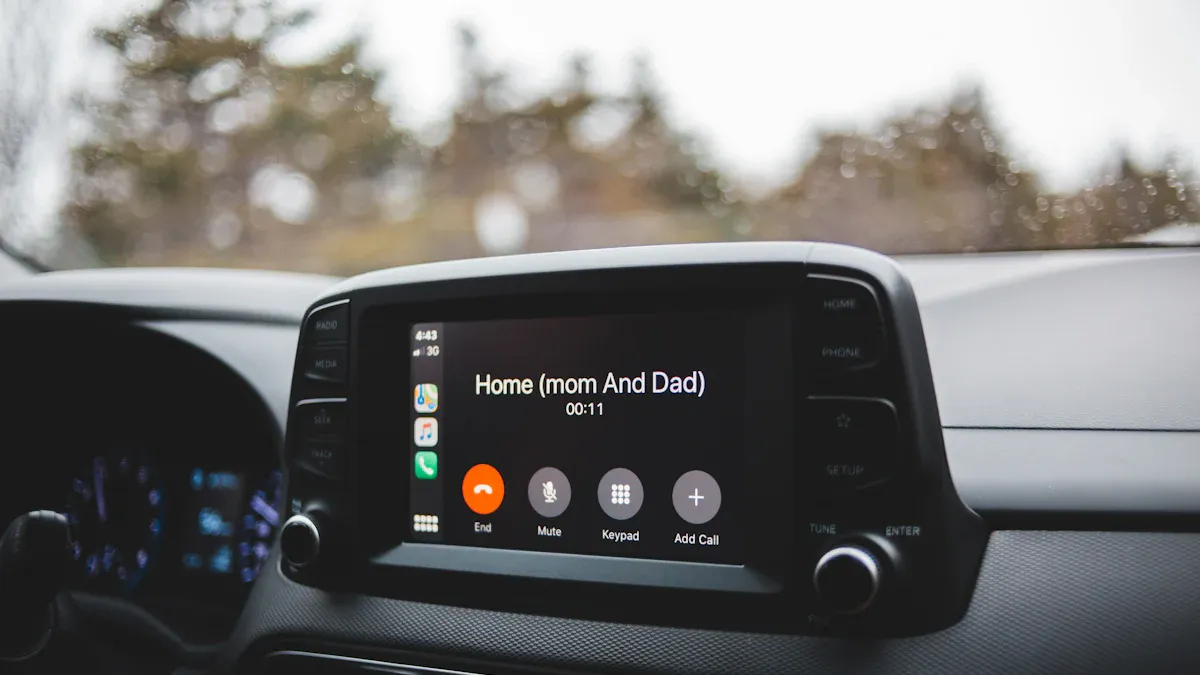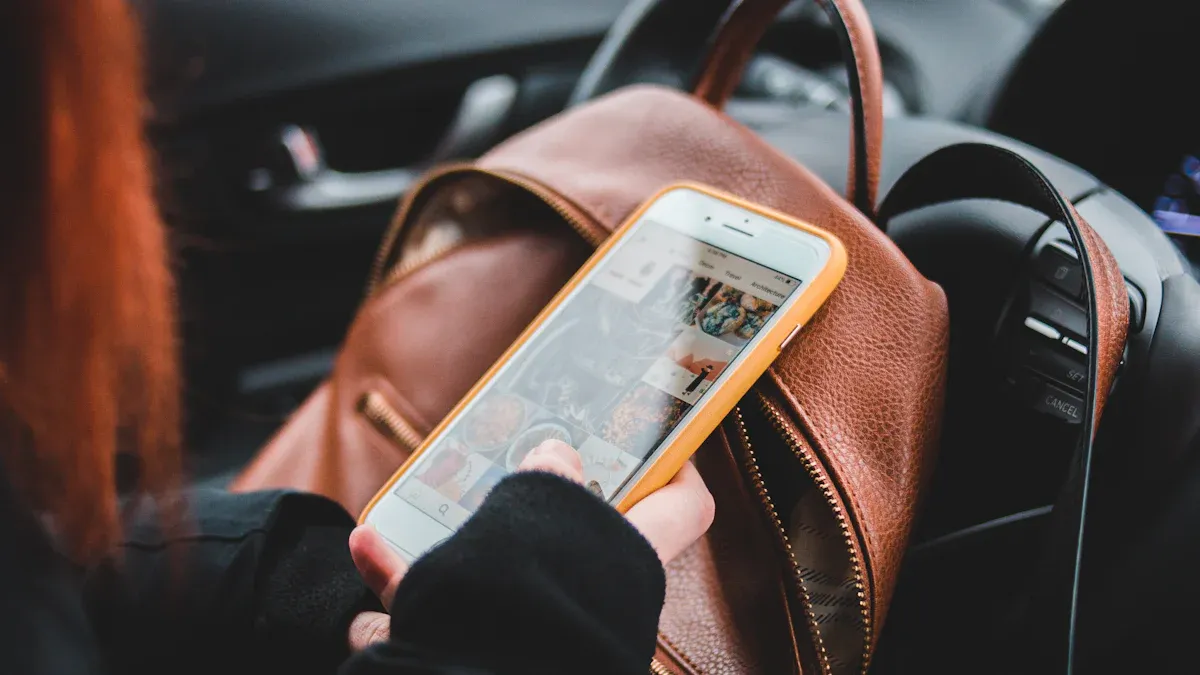
Media companies negotiate with ride-hailing companies to install LCD advertising screens in cars. Many believe these negotiations help reach urban audiences. Media companies aim to use car-top displays, backseat screens, and digital license plates. Technology and data play a crucial role in these negotiations. Both parties seek targeted ads, data insights, and increased revenue. 🚗
Key Takeaways
Media companies and ride-hailing companies team up to put LCD screens in cars. This helps them show ads to more people in cities. The ads are made for certain groups of people.
They talk about what kind of screens to use. They also talk about who gets special rights, how to share data, and how to follow local laws. This helps them make good and legal deals.
LCD screens let brands show ads to many people fast. The ads are bright, use location, and can be interactive. These ads help keep riders interested.
Most companies split the money they make from ads. This helps both media and ride-hailing companies do better together.
Using data and AI makes ads better for each person. It also helps pick the right content. Fixing tech and user problems keeps ads safe and useful.
Negotiation Points

How Media Companies Negotiate
Media companies talk with ride-hailing companies about value, reach, and technology. They look at what each side can offer. For example, Firefly works with ride-hailing fleets to put digital screens on top of cars. These screens show ads that change by place and time. Adkom helps media buyers and ride-hailing operators build ad networks in cities. T-Mobile has tried to grow its digital out-of-home (DOOH) ads by using ride-hailing cars as moving billboards.
Media companies want to use big fleets to show more ads and reach more people. They share data about how ads can help brands and make more money to get ride-hailing companies interested.
There are many steps in these talks:
Media companies suggest test programs to show how LCD screens work.
Both sides talk about what screens need, like being tough and fitting in cars.
They plan how to put in, fix, and update the screens and ads.
Media companies ask for data to see how well ads do and who sees them.
Exclusive rights are a big part of talks. Some media companies want to be the only ones with screens in a city or area. This can stop others from joining and make the deal worth more. But, exclusive rights can cause problems, especially where taxi companies have special rules or rights.
Key Terms and Agreements
Key terms help decide if the partnership will work. The main points are:
Screen Types: Media companies want to put in different screens, like car-top displays, backseat tablets, or digital license plates. Each type has its own ad style and tech needs.
Exclusive Rights: Some deals give one media company all the ad rights. In some cities, taxi companies have special rights to certain spots or ride-hailing zones. These rights can make legal or rule problems for ride-hailing companies and their media partners.
Data Sharing: Getting data is very important. Media companies want real-time info about where cars are, who rides, and how many see the ads. This data helps them make ads better and show their value.
Talks also cover rules and laws. Some cities make drivers take tests or upgrade payment systems. These rules can change how media companies put in screens or get data. In France, strict rules and taxi rights have caused legal fights and even police actions against ride-hailing companies. These problems show how local laws can change how talks go.
Key Term | Description | Impact on Negotiation |
|---|---|---|
Screen Types | Car-top, backseat, digital license plates | Decides ad style and who sees ads |
Exclusive Rights | Only one company can use fleets or zones | Stops others, makes deal worth more |
Data Sharing | Info about where, how, and who sees ads | Helps target and check ads |
Regulatory Terms | Following local laws and tech rules | Can help or hurt partnerships |
Media companies try to balance these terms for good deals. They want the best screen spots, exclusive access, and strong data while following local rules. Ride-hailing companies want to make more money and keep their main business running smoothly.
Advertising Value

Audience Reach
Ride-hailing vehicles with LCD screens help brands reach many city people. These screens are on car tops and inside cars. Passengers and people outside can see the ads. Digital screens are bright and easy to notice in busy places. Brands get seen fast.
High Visibility: LCD screens show ads in busy areas. More people can see the message.
Rapid Activation: Brands can start new ads quickly. Digital screens let ads change fast, so they stay new.
Geographic Targeting: Advertisers can pick certain neighborhoods or zip codes. This helps the right people see the ads at the best time.
Digital taxi advertising reaches both riders and people walking by. This gives brands more chances to be seen than regular ads.
Metric | Description |
|---|---|
Counts how many people walk by the screen. | |
Opportunity to See (OTS) | Measures how long people could see the ad. |
Audience Demographics | Shows the age and gender of people who see the ad. |
Engagement Duration | Tracks how long people look at the ad. |
Targeting and Engagement
LCD screens inside ride-hailing cars do more than just show ads. They help brands target the right people and keep them interested. Brands can change ads to fit the passenger’s age, likes, or where they are going. This makes ads more fun and useful.
Custom Content: Screens show different ads for each rider and trip.
Interactive Features: Some screens let riders touch or swipe to learn more. This makes people pay more attention to the brand.
Captive Audience: Passengers often look at screens during rides. They remember the ads better.
Campaigns with interactive LCD screens often get more people to know the brand and take action. Brands use things like click-through rate and video completion rate to see if ads work. Many people respond to targeted ads on the same day. LCD screens in ride-hailing cars help brands connect with people and get them interested.
Revenue Models
Fee Structures
Media companies and ride-hailing operators use different ways to get paid for LCD advertising. The most popular way is revenue sharing. Both sides split the money from ads on the screens. This helps everyone win when ad sales go up. Many deals around the world use this method. It works because both companies want to grow together.
Some companies use other ways to pay. Agencies might get a set commission based on ad spending. Project-based fees pay for each campaign or service. Retainer models give agencies steady pay every month for their work. Some deals use value-based fees. Here, payment depends on how many ads show or the value given. Performance-based models pay only if ads lead to sales or results. These are not as common but can push for better results.
Revenue sharing is the top pick because it helps both media and ride-hailing companies reach the same goals.
Fee Structure Type | Description | Usage and Benefits |
|---|---|---|
Revenue Sharing | Split ad revenue between partners | Most common; aligns interests |
Commission | Fixed percentage of ad spend | Simple; used in traditional and digital media |
Project-Based | Payment per campaign or project | Flexible; good for short-term work |
Retainer | Regular monthly payment for ongoing services | Stable income; often paired with incentives |
Value-Based | Payment per ad shown or value delivered | Encourages efficiency; less common |
Performance-Based | Payment based on sales or results | Motivates outcomes; rare in pure form |
Partnership Models
Partnership models decide how media companies and ride-hailing operators work together. Strategic partnerships often last a long time. These deals may give one company the only right to put screens in some fleets or cities. Some companies make joint ventures to share risks and profits. Others use licensing. Here, the ride-hailing company lets a media partner run screens for a set fee.
Exclusive Partnerships: One media company gets to put screens in a fleet or area. This can keep out rivals and make the deal worth more.
Joint Ventures: Both companies start a new business together. They share costs, profits, and choices.
Licensing Agreements: The ride-hailing company lets a media partner use its cars for ads. The partner pays a fee or shares the money.
These partnership models help both sides trust each other and plan ahead. They also let the business grow as the digital out-of-home market changes. 🚕
Maximizing Effectiveness
Data-Driven Strategies
Media companies use data to make LCD ads work better. They look at where customers spend time. This helps them show ads in the best places. Companies use content that matches what people like and what is popular. Artificial intelligence helps pick the best time and place for ads.
Companies watch numbers like how many people see the ads. Dashboards show how ads do each day.
GPS helps send ads to certain neighborhoods or during events.
Time-based ads show up during busy hours or big city events.
Dynamic ads change with things like weather or where the car is.
A/B testing lets companies see which ad works better.
Advertisers can change ads fast using live data. This makes ads more useful and helps them get better results.
AI tools guess the best times and places for ads. They help spend money on the best spots. Tools also track how many people walk by, remember the brand, or buy something. This helps companies make better ads next time.
Content Customization
Changing content helps keep riders interested and helps brands. LCD screens in ride-hailing cars show ads that fit the rider’s age, likes, and where they are. This makes ads more fun and useful.
Interactive ads like polls and quizzes let riders join in.
Ads show up when riders are most likely to pay attention.
Geo-targeted ads use location to give offers that fit where the car is.
Custom ads make rides less boring and more fun. Riders get info, games, and deals. Brands can reach the right people and change ads fast. This helps brands get noticed and do better. Drivers make more money, riders enjoy the trip, and brands get more people to care. 🚕
Challenges and Solutions
Regulatory Issues
Media and ride-hailing companies face many rule problems with LCD screens. Laws change fast because these services are new. Some cities call ride-hailing transportation. Others say it is a digital service. This makes rules different in each place. It is hard to keep rules the same everywhere.
Strict rules try to stop driver distraction and too many bright lights. Local leaders want screens tested and designed well before use. Too many rules, like in Vancouver, slow down new ideas and stop fair competition. Flexible rules help companies like Uber try new things.
Data privacy and safety are big worries. Companies must keep user data safe and follow privacy laws. If not, they can get into legal trouble.
Technical Barriers
Technical problems can make it hard to put LCD screens in cars. Screens must work in bright sun and at night. Some screen designs do not change, so people cannot see them well.
Companies use some fixes:
Louver films cut down on glare at night.
Optical adhesives and mirror films make screens clearer.
Smart software changes screen brightness and contrast as needed.
These upgrades help people see screens better and stop complaints.
User Experience
User experience is important for drivers and riders. Bad screens can bother people or distract drivers. Now, companies use screens that change with light and what users need. This makes rides safer and more comfortable.
A good user experience plan has:
Checking if screens are easy to use.
Eye-tracking to put info where it is not distracting.
Asking users for feedback to make screens better.
By listening to users and testing often, companies make rides safer and more fun for everyone.
Media and ride-hailing companies can make LCD ads better with data. They use targeting, changing content, and good partnerships. Companies like Lyft and Curb use ads that show up in certain places. They pay drivers fairly and use screens that are simple to use. When companies spend money on geofencing, analytics, and interactive screens, more people pay attention. This also helps them earn more money. The global DOOH market is growing quickly. Smart cities, AI, and new screen technology help this growth. Companies that try new things and care about users will lead in car ads. 🚗
FAQ
What types of LCD screens do ride-hailing vehicles use?
Ride-hailing cars have car-top displays, backseat tablets, and digital license plates. Each screen shows ads in a different way. Car-top screens let people outside see the ads. Backseat tablets show ads to riders during their trip.
How do companies measure ad performance on these screens?
Companies count how many people see the ads. They also check how long people watch the ads. Dashboards help track these numbers and where the car goes. This information helps make ads better next time.
Are there privacy concerns with in-car advertising?
Yes, privacy is important. Companies must keep rider data safe and follow privacy rules. They usually use data that does not show who you are. Riders can often choose what information they want to share.
How do drivers benefit from LCD advertising screens?
Drivers make extra money by sharing ad revenue. Some get bonuses for driving busy routes. Drivers also get new tech and help if screens need fixing.
What happens if a screen malfunctions during a ride?
Most companies help fast when screens break. Drivers can report problems using an app or by calling a hotline. Technicians fix or swap broken screens so ads keep working.
See Also
Budget-Friendly Portable CarPlay Solutions Suitable For All Drivers
Top CarPlay Adapters Supporting Netflix Reviewed And Ranked
Best HDMI Dongles For 4K CarPlay Streaming In 2025
Cost-Effective Portable CarPlay Devices Designed For BMW F10
Audi Tesla-Inspired CarPlay Displays Compared By Features And Cost
